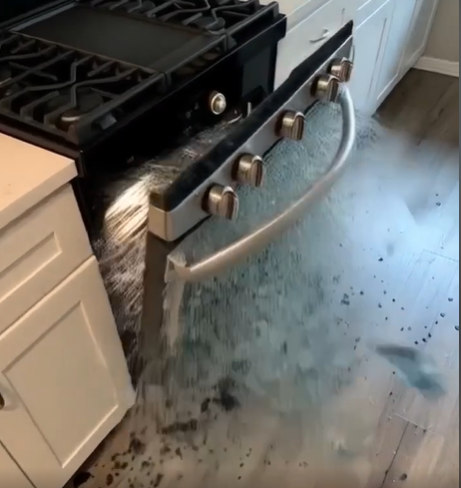When Oven Doors Explode: Understanding the Hidden Dangers of Kitchen Appliances
Introduction
The modern kitchen is a symbol of convenience. Appliances such as ovens, stovetops, and microwaves make everyday cooking faster, safer, and more efficient. We often take for granted that these devices, designed with years of engineering and testing, will function flawlessly throughout their lifetimes. Yet, from time to time, unsettling stories remind us that even the most ordinary household tools can pose surprising risks.
One such phenomenon has alarmed homeowners across the globe: oven doors that suddenly shatter or even “explode” without warning. Unlike dramatic appliance failures caused by fires, sparks, or smoke, this danger often occurs quietly, in an instant, and sometimes when the oven is not even in use. The result is an unexpected mess of broken glass scattered across the kitchen floor.
This article explores why this happens, how the design and materials of modern ovens play a role, and—most importantly—what you can do to protect your home and family from such hidden dangers.
The Unsettling Reality: When Glass Doors Shatter Unexpectedly
Imagine standing in your kitchen when, without warning, the oven door bursts apart, sending fragments of glass across the floor. Many homeowners have reported this exact situation, sometimes while cooking, other times when the appliance was completely switched off.
The experience can feel surreal, almost like something out of a nightmare. After all, we expect danger from an active appliance—perhaps from an overheated stovetop or faulty wiring. But when an oven is not even in operation, how could it suddenly become hazardous?
Consumer safety forums and news outlets have highlighted dozens of these cases. In some households, the noise resembles a gunshot. In others, the explosion happens silently, leaving nothing but shattered glass across the kitchen. While the damage may not always cause physical harm, the cleanup and emotional shock leave lasting impressions.
Understanding Oven Glass: Then and Now
To grasp why oven doors can shatter, it helps to look at the materials used to make them.
Borosilicate Glass: The Old Standard
In past decades, oven doors were commonly made from borosilicate glass. This type of glass, known for its durability, is highly resistant to sudden temperature changes. You may recognize borosilicate from laboratory beakers and cookware like Pyrex. Its ability to withstand rapid heating and cooling made it ideal for high-temperature environments.
Soda-Lime Glass: The Modern Alternative
Today, many manufacturers have shifted toward sodium-calcium (soda-lime) glass. The reason is simple: it’s cheaper to produce. While soda-lime glass is strong under normal conditions, it is significantly more vulnerable to thermal shock compared to borosilicate glass. This means that when exposed to rapid changes in temperature, soda-lime glass is more likely to fracture.
For cost-conscious manufacturers, soda-lime glass has become the material of choice. But for consumers, this cost-saving change has introduced new risks.
Invisible Weaknesses: Why Glass Sometimes Fails
Even beyond material choice, oven glass can harbor microscopic imperfections that eventually lead to catastrophic failure. One common culprit is nickel sulfide inclusions—tiny mineral impurities embedded during the glass manufacturing process.
At first, these flaws are invisible. But over time, and through countless cycles of heating and cooling, the inclusions expand and contract differently than the surrounding glass. Slowly, they generate internal stress. Eventually, the stress reaches a breaking point, causing the glass to shatter suddenly and violently.
To make matters worse, small scratches, chips, or knocks to the oven door can accelerate this process. A gentle bump from a cooking pot, an abrasive cleaning pad, or even the act of closing the oven door too firmly may create micro-cracks. These weaknesses may remain unnoticed for weeks or months—until one day the entire pane bursts apart.
Real-Life Consumer Experiences
Consumer protection agencies and safety boards have received numerous reports of oven glass shattering. Many of these accounts share common themes:
- Unexpected timing: Doors breaking while the oven is off.
- Minimal provocation: A gentle touch or a routine cleaning session before sudden failure.
- Silent danger: Sometimes no warning signs are visible before the glass gives way.
One homeowner described waking up to find the oven door completely shattered overnight, despite no recent use. Another recounted how the glass exploded mid-baking, scattering shards onto the food inside. These cases demonstrate that while rare, the issue is widespread enough to warrant concern.
Why Modern Ovens Are More Vulnerable
The increase in reported incidents is not coincidental. Several factors contribute to why contemporary ovens may be more prone to glass breakage:
- Material Substitution – As noted, soda-lime glass is less durable than borosilicate.
- Thinner Panels – To save on costs and reduce weight, glass thickness may be reduced.
- Higher Heat Cycles – Modern ovens often feature advanced functions, including self-cleaning cycles, which expose glass to extreme temperatures.
- Design Aesthetics – Larger glass panels used for sleek designs increase the surface area, which can amplify stress distribution.
While manufacturers follow safety standards, these combined changes can introduce vulnerabilities not seen in older oven models.
Common Triggers for Glass Breakage
While some incidents seem spontaneous, there are known factors that can increase the likelihood of an oven door shattering:
- Mechanical Stress: Slamming the oven door or hitting it with heavy cookware.
- Abrasion: Using harsh cleaning tools or chemicals that weaken the glass surface.
- Heat Extremes: Running self-cleaning cycles frequently, which expose the glass to extreme conditions.
- Pre-existing Damage: Chips, scratches, or cracks that spread over time.
Often, it’s not a single event but a combination of these factors that leads to eventual failure.
The Science of Glass Failure
Glass may look smooth and solid, but on a microscopic level, it contains structural irregularities. When glass is subjected to stress—whether thermal or mechanical—these irregularities can magnify the pressure at specific points.
During heating, glass expands. During cooling, it contracts. If certain areas expand or contract unevenly, internal stress builds up. Over many cycles, this stress accumulates until the glass can no longer contain it, leading to a sudden fracture.
Warning Signs to Watch For
Although some failures occur without visible warnings, there are signs that homeowners can look for:
- Fine cracks or chips around the edges of the glass.
- Cloudiness or discoloration in the pane.
- Loose or rattling panels when opening or closing the door.
- Unusual sounds like creaks or pops when the oven is in use.
Regular inspections can help catch early damage before it escalates into a major hazard.
Safety Precautions Every Homeowner Should Take
To reduce the risk of experiencing a shattered oven door, consider the following practices:
- Gentle Handling – Always close the oven door softly.
- Careful Cleaning – Avoid abrasive sponges or harsh chemicals. Use non-scratch cloths instead.
- Limit Self-Cleaning – While convenient, self-cleaning cycles reach extreme temperatures that stress the glass. Use sparingly.
- Routine Inspections – Check for chips, cracks, or loose glass panels regularly.
- Immediate Action – If you suspect damage, contact a certified technician rather than continuing use.
The Role of Manufacturers and Consumer Rights
Appliance manufacturers are responsible for ensuring their products meet safety regulations. However, occasional defects can still occur.
If your oven glass shatters:
- Document the incident with photos.
- Contact the manufacturer to report the issue.
- Check for recalls or service bulletins related to your oven model.
- Consult consumer protection agencies if the manufacturer does not respond appropriately.
In some cases, consumers may be entitled to free repairs, replacements, or refunds depending on warranty coverage and local laws.
What To Do If Your Oven Door Shatters
If the worst happens, follow these steps immediately:
- Keep a safe distance until all glass fragments settle.
- Wear protective gloves and shoes before cleanup.
- Sweep large shards carefully into a container—never use bare hands.
- Vacuum smaller fragments from surrounding areas.
- Contact a repair service before attempting to use the oven again.
Do not attempt temporary fixes with tape or glue. Only a professional repair or replacement can restore safety.
Long-Term Maintenance and Prevention
Like any appliance, ovens require regular maintenance. Beyond glass care, keeping hinges lubricated, seals intact, and electronics inspected ensures long-term safety and performance. Investing time in routine care not only prevents hazards but also extends the lifespan of the appliance.
Expert Opinions and Research Insights
Materials scientists continue to study glass failures in appliances. Research shows that while complete elimination of risk is impossible, improvements in manufacturing quality control can significantly reduce incidents. Experts recommend stronger safety testing, including stress simulations and long-term durability trials, before ovens reach consumers.
Conclusion: Vigilance Is the Best Protection
The possibility of an oven door shattering without warning may seem unsettling, but awareness is the first step toward prevention. By understanding the factors that cause glass failure—ranging from manufacturing materials to everyday wear and tear—homeowners can take simple precautions to safeguard their kitchens.
Even in the age of advanced technology, sometimes the most ordinary appliances can surprise us with hidden risks. Staying vigilant, practicing safe habits, and responding quickly to early signs of damage can make the difference between a minor inconvenience and a major household hazard.
In short: treat your oven with care, monitor it regularly, and never ignore small signs of damage. What appears insignificant today could lead to tomorrow’s dangerous surprise.




